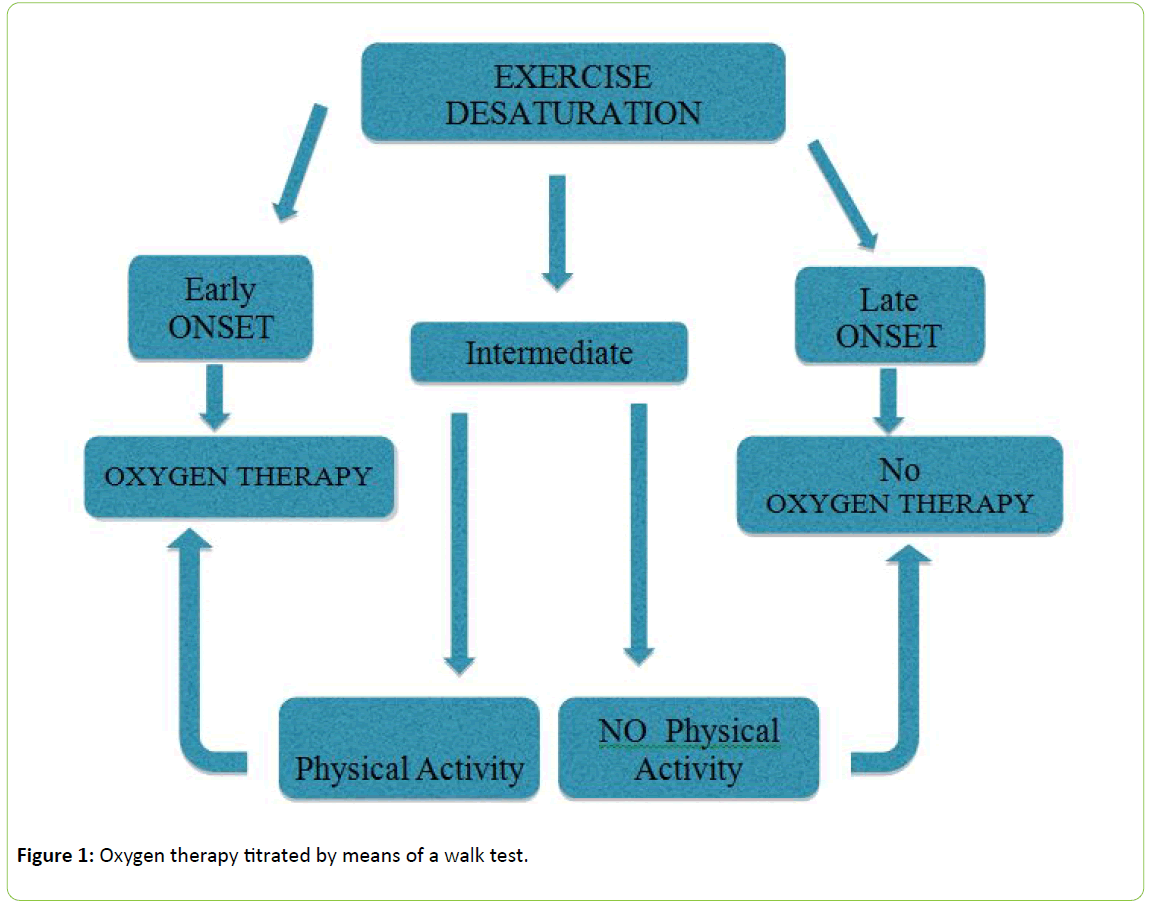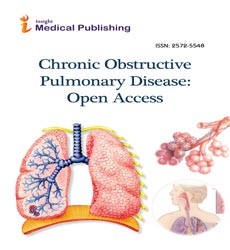Ambulatory Oxygen Therapy in COPD Patients with Oxygen Desaturation during Exercise
Ignacio García-Talavera, Juan M. Figueira-Gonçalves
DOI10.21767/2572-5548.100005
Ignacio García-Talavera* and Juan M. Figueira-Gonçalves
Respiratory Department, Candelaria University Hospital, Research Canary Foundation-Funcanis, Tenerife, Spain
- *Corresponding Author:
- García-Talavera I, MD
Respiratory Department, Candelaria University Hospital
Research Canary Foundation-Funcanis, Tenerife, Spain
E-mail: igarmark@gmail.com
Received Date: December 28, 2015 Accepted Date: January 18, 2016 Published Date: January 25, 2016
Citation: Talavera IG, Gonçalves JMF (2016) Ambulatory Oxygen Therapy in COPD Patients with Oxygen Desaturation during Exercise. Chron Obstruct Pulmon Dis 1:5. doi: 10.21767/2572-5548.100005
Copyright: © 2016 García-Talavera I, et al. This is an open-access article distributed under the terms of the Creative Commons Attribution License, which permits unrestricted use, distribution, and reproduction in any medium, provided the original author and source are credited.
Abstract
Desaturation during exercise is no longer an anecdote or medical curiosity but has converted into a marker of poor prognosis. Patients with COPD who undergo rapid or early desaturation during the six-minute walking test will have major clinical repercussions than those with late-onset desaturation. Only the patients who exhibit desaturation within the first minute of the walk test, the so-called early desaturators, also experience desaturation during their daily activities. Those who desaturate past 3.5 min, the late desaturators, do not undergo desaturation in their daily life activities. Moreover, the former will require long-term oxygen therapy sooner than the late-onset group. It seems reasonable to assume that early desaturators will benefit from ambulatory oxygen therapy, as they will desaturate during their activities of daily living. Late-onset desaturators will not experience oxygen desaturation in their daily lives. Consequently, they would not benefit from oxygen therapy while walking around. However, depending on the individual case and their activity, those intermediate desaturators—with an onset between 1 and 3.3 min—may go through desaturation at home.
Short Communication
To date, oxygen desaturation during exercise in chronic obstructive pulmonary disease (COPD) is still a scarcely studied aspect. In fact, there is no consensus on the definition of desaturation with exercise. Some authors define it as a drop in oxygen saturation of more than 4% [1]; others as minimum levels of oxygen saturation below 90% [2]; while for other authors, in addition to low saturation levels (below 88-90%), the condition is to be maintained for more than 1 min [3]. The probably most accepted criterion in clinical practice is a drop of 4% with a nadir below 88%.
Moreover, the dilemma consists in deciding what to do with the patient who suffers from desaturation, i.e. perform tighter clinical controls, give oxygen or not and when and at which flow. The current national and international guidelines do not provide relevant, precise information [4-7]. Desaturation during exercise is no longer an anecdote or medical curiosity but has converted into a marker of poor prognosis. Takigawa et al. [8] highlighted in their work from 2007 the increased mortality found in patients with COPD who desaturated by more than 6% with exercise. Recently, Andranopoulus et al. [9] confirmed that desaturation correlates with an increased number of hospital admissions and decreased survival.
Only the patients who exhibit desaturation within the first minute of the walk test, the so-called early desaturators, also experience desaturation during their daily activities [10]. Those who desaturate past 3.5 min, the late desaturators, do not undergo desaturation in their daily life activities. Thus, although patients who suffer from desaturation altogether seem to have a worse prognosis than those who do not, patients with COPD who undergo rapid or early desaturation during the six-minute walking test will have major clinical repercussions than those with late-onset desaturation. Moreover, the former will require long-term oxygen therapy sooner than the late-onset group [11].
The six-minute walking test is considered a submaximal exercise that can become maximal in some patients, wherein the oxygen consumption correlates well with the peak oxygen consumption obtained by cycle ergometry [12]. However, a patient may not go through desaturation at home if the daily physical activity is low. A patient who does not walk, will obviously not reach desaturation. Outside the hospital, many patients with low mobility will not recreate the pathophysiological conditions that occurred during the walk test in the hospital.
In light of the impact of desaturation, in particular early desaturation, the question arises whether or not to administer oxygen to patients. Current guidelines and clinical standards do not provide clear information; in line with them, oxygen may be administered individually when an improved exercise capacity is observed in the patient. It seems reasonable to assume that early desaturators will benefit from ambulatory oxygen therapy, as they will desaturate during their activities of daily living. Late-onset desaturators will not experience oxygen desaturation in their daily lives. Consequently, they would not benefit from oxygen therapy while walking around. However, depending on the individual case and their activity, those intermediate desaturators—with an onset between 1 and 3.3 min—may go through desaturation at home.
That being said, the question is how to administer the oxygen. We recommend a walk test with oxygen administration while assessing improvements in walking distance, degree of dyspnea, post-exercise recovery period, and the oxygen flow needed for these changes. Thus, titrating their ambulatory oxygen therapy, these patients with usually serious COPD will not desaturate with exercise. As a result of this titration, based on submaximal exercise, the patient will neither desaturate during the walk test nor during activities of daily living. Despite oxygen requirements being somewhat lower, the titer will certainly be set higher to avoid daily desaturation.
However, there is still the group of intermediate patients, neither early nor late desaturators, where the risk of desaturating at home is uncertain. In these cases, their level of physical activity could be assessed by questionnaire. If the questionnaire revealed a considerable daily physical activity, we would recommend to start oxygen therapy, again titrated by means of a walk test in hospital (Figure 1).
In summary, we propose the administration of ambulatory oxygen in patients with COPD who desaturate during exercise, awaiting further studies to confirm the benefits of oxygen therapy in these patient groups.
Conflicts of Interest
The authors declare no conflicts of interest.
References
- Poulain M, Durand F, Palomba B, Ceugniet F, Desplan J, et al.(2003) 6-minute walk testing is more sensitive than maximal incremental cycle testing for detecting oxygen desaturation in patients with COPD. Chest; 123: 1401–1407.
- Van Gestel AJ, Clarenbach CF, Stowhas AC, Teschler S, Russi EW, et al. (2012)Prevalence and prediction of exercise-induced oxygen desat- uration in patients with chronic obstructive pulmonary disease. Respiration;84: 353–359.
- Zafar MA,Tsuang W, Lach L, Eschenbacher W, PanosRJ (2013)Dynamic hyperinflation correlates withnexertional oxygen desaturation in patients with chronic obstructive pulmonary disease. Lung ; 191: 177-182.
- Miravitlles M, Soler-Cataluña JJ,Calle M, Molina J,Almagro P,et al. (2014)Guíaespañola de la EPOC (GesEPOC). Actualización 2014. Arch Bronco neumol; 50:1-16.
- VestboJ, Hurd SS, Agusti AG, Jones PW, Vogelmeier C, et al. (2013) Global Strategy for the Diagnosis, Management and Prevention of Chronic Obstructive Pulmonary Disease, GOLD Executive Summary. Am J RespirCrit Care Med;187:347-365.
- Ortega Ruiz F,DíazLobato S,GaldizIturri JB,García Rio F,Güell Rous R,et al. (2014)Oxigenoterapia continua domiciliaria. Arch Bronconeumol; 50: 185-200.
- BTS Guidelines for home oxygen use in adults (2015) Thorax; 70: 1-43.
- Takigawa N, Tada A, Soda R, Date H, Yamashita M, et al. (2007) Distance and oxygen desaturation in 6-min walk test predict prognosis in COPD patients. Respir Med;101:561-567.
- AndranopoulusV, Wouters EF, Pinto-Plata VM, Vanfleteren LE, Bakke PS, et al. (2015) Resp Med; 109: 1138-1146.
- García-Talavera I, García CH, Macario CC, de Torres JP, Celli BR, et al. (2008) Time to desaturation in the 6-min walking distance test predicts 24-hour oximetry in COPD patients with a PO2 between 60 and 70mmHg. Respir Med;102:1026-1032.
- Garcia-Talavera I, Tauroni A, Trujillo JL, Pitti R, Eiroa L, et al. (2011) Time to desaturation less than one minute predicts the need for long-term home oxygen therapy. Respir Care; 56:1812.
- Trooster T, Vilaro J, Rabinovich R, Casa A, Barberá JA,et al. (2002)Physiological responses to the 6-min walk test in patients with chronic obstructive pulmonary disease. ERJ; 20: 564-569.
Open Access Journals
- Aquaculture & Veterinary Science
- Chemistry & Chemical Sciences
- Clinical Sciences
- Engineering
- General Science
- Genetics & Molecular Biology
- Health Care & Nursing
- Immunology & Microbiology
- Materials Science
- Mathematics & Physics
- Medical Sciences
- Neurology & Psychiatry
- Oncology & Cancer Science
- Pharmaceutical Sciences

